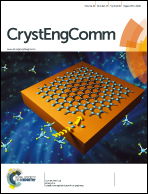Metal-directed assembly of coordination polymers with the versatile ligand 2-(1H-benzotriazol-1-yl) acetic acid: from discrete structures to two-dimensional networks†
Abstract
Eight new metal coordination complexes, namely, [Co(BTA)2(H2O)4]·6H2O (1), [Ni(BTA)2(H2O)4]·6H2O (2), [Cu2(HBTA)4(BTA)2]·2H2O (3), [Ag(BTA)(H2O)]n (4), [Zn(BTA)2(H2O)]n (5), [Cd(BTA)2(H2O)]n (6), [Cu2(μ3-OH)(BTA)3]n (7), and [Mn(BTA)2(H2O)2]n (8) [HBTA = 2-(1H-benzotriazol-1-yl)acetic acid], were obtained under hydrothermal conditions, by reacting the different metal salts with HBTA. The ligand HBTA was characterized by melting point (m.p.), elemental analysis (EA), infrared spectroscopy (IR), 1H NMR, and X-ray single-crystal diffraction. Complexes 1–8 were structurally characterized by X-ray single-crystal diffraction, EA, IR, PXRD, and thermogravimetry analysis (TGA). These complexes all display low-dimensional features displaying various zero-dimensional (0D), one-dimensional (1D), and two-dimensional (2D) coordination motifs. Complexes 1 and 2 are isostructural and mononuclear; they show unique decamer water clusters with bis-boat conformations, which further extend to a 1D metal–water chain. Through intermolecular hydrogen bonds, these 1D metal–water chains extend to 3D supramolecular networks. Complex 3 shows a bi-nuclear structure. Complex 4 displays a 1D tape structure. There exist weak interactions between Ag⋯Ag. Complexes 5 and 6 form a 1D linear chain bridged by BTA anions. Complex 7 exhibits a 2D layer containing tetranuclear butterfly [Cu4(CO2)4(μ3-OH)] secondary building units (SBUs). Complex 8 possesses a 2D layer and further stacks via hydrogen bonding interactions to generate a three-dimensional supramolecular architecture. These results suggest that both the coordination preferences of the metal ions and the versatile nature of this flexible ligand play a critical role in the final structures. The luminescent spectra show strong emission intensities in complexes 3, 4, 5, and 6. Complexes 3, 5 and 6 display blue photoluminescence. However, complex 4 exhibits green fluorescence. Variable-temperature magnetic susceptibility measurements reveal the existence of antiferromagnetic interactions in both 7 and 8. Additionally, the ferroelectric and second-harmonic generation (SHG) properties of 5 are discussed in detail.


 Please wait while we load your content...
Please wait while we load your content...